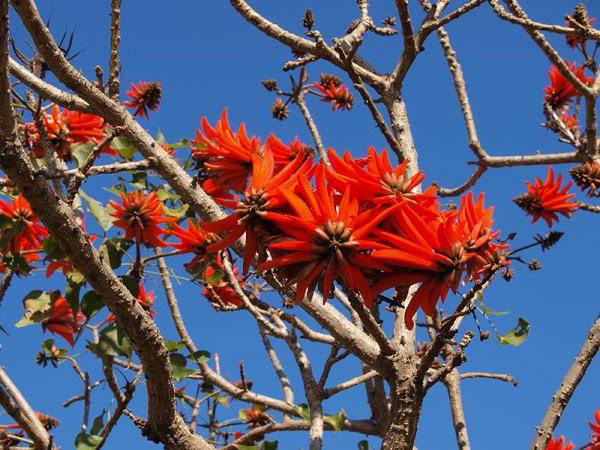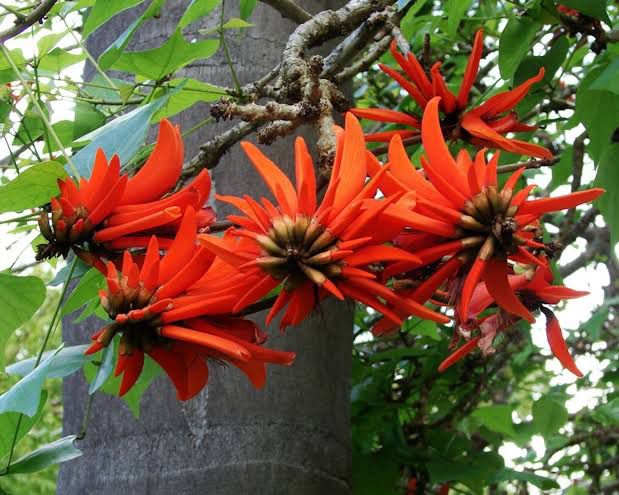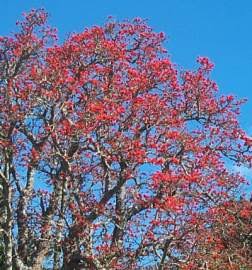Erythrina lysistemon, commonly referred to as the Lucky Bean Tree, is a remarkable medicinal plant that has been cherished for centuries due to its numerous health benefits.
The historical significance of Erythrina lysistemon in traditional medicine is deeply rooted. Indigenous communities in various parts of the world, especially in southern Africa, have long recognized the therapeutic potential of this plant. Let’s journey through time to explore its history of medicinal plant use.
The Botanical Description of Erythrina lysistemon
1. Life: Erythrina lysistemon is a deciduous tree, which means it sheds its leaves annually. It belongs to the Fabaceae family and is characterized by a tall and robust stature, reaching heights of up to 10 meters or more.
2. Leaves: The leaves of Erythrina lysistemon are compound, with three distinct leaflets. They are bright green and provide an attractive canopy during the growing season.
3. Flowers: One of the most striking features of this plant is its vibrant scarlet-red flowers. These flowers are arranged in dense clusters and are a visual spectacle, attracting pollinators like bees and birds.
4. Fruits: The Lucky Bean Tree produces pods that contain bright red seeds, which are often referred to as “lucky beans.” These seeds have cultural and medicinal significance in many societies.
5. Bark: The bark of Erythrina lysistemon is smooth and grayish in color. It is an important part of the plant used in traditional medicine.
6. Roots: The roots are sturdy and can extend deep into the soil, providing stability to the tree. They also contain compounds with medicinal properties.
7. Habitat: This plant is native to southern Africa and is commonly found in woodland areas, grasslands, and along riverbanks. It thrives in well-drained soils and is often seen as a valuable addition to agroforestry systems.
The Geographic Distribution of Erythrina lysistemon
Erythrina lysistemon, commonly known as the Lucky Bean Tree, exhibits a specific geographic distribution that plays a crucial role in its cultivation and availability. Here are six key aspects of its geographic distribution:
1. Native Range: Erythrina lysistemon is native to southern Africa, particularly found in countries such as South Africa, Zimbabwe, Mozambique, and Botswana. It thrives in the subtropical and tropical regions of this area.
2. Altitude Preferences: This tree prefers elevations ranging from sea level to about 1,800 meters (5,900 feet) above sea level. It can adapt to various altitudes within this range.
3. Climate Requirements: Erythrina lysistemon is well-suited to regions with a mild to warm climate. It can tolerate both dry and humid conditions, making it versatile in its geographic range.
4. Soil Adaptability: The Lucky Bean Tree grows in a variety of soil types, including sandy, loamy, and clay soils. It is often found along riverbanks and in grasslands.
5. Rainfall Patterns: While it can endure periods of drought, Erythrina lysistemon typically thrives in areas with a consistent annual rainfall between 500 and 1,200 millimeters (20 to 47 inches).
6. Ecological Role: In its native range, this tree plays a significant ecological role by providing shade, enriching the soil with nitrogen through its root nodules, and supporting local wildlife with its nectar-rich flowers.
The Chemical Composition of Erythrina lysistemon
Erythrina lysistemon is known for its diverse chemical composition, which contributes to its medicinal properties. Here are seven important components found in this plant:
1. Alkaloids: Erythrina lysistemon contains alkaloids such as erythristemine and erysodine, which have been studied for their potential pharmacological effects.
2. Flavonoids: Flavonoids, including quercetin and kaempferol, are present in the leaves and flowers of the plant. These compounds have antioxidant and anti-inflammatory properties.
3. Tannins: Tannins are compounds found in the bark and roots of the Lucky Bean Tree. They have astringent properties and may be involved in its traditional medicinal uses.
4. Glycosides: Glycosides like erythraline and erysotrine are identified in various parts of the plant and may contribute to its therapeutic effects.
5. Phenolic Compounds: Erythrina lysistemon contains phenolic compounds, which have antioxidant and anti-inflammatory properties.
6. Saponins: Saponins, present in the plant’s roots, are known for their foaming properties and may have potential health benefits.
7. Isoflavonoids: Some isoflavonoids, such as erybraedin C, have been isolated from this plant and are subjects of ongoing research for their medicinal properties.
Understanding the chemical composition of Erythrina lysistemon is essential for harnessing its full therapeutic potential.
The Cultivation and Growth of Erythrina lysistemon
Cultivating Erythrina lysistemon requires careful attention to its growth requirements. Here are seven key aspects of its cultivation and growth:
1. Climate Considerations: Erythrina lysistemon thrives in regions with a mild to warm climate. It is sensitive to frost and requires protection in cooler climates.
2. Soil Preparation: Prior to planting, ensure well-drained soil with good organic matter content. Loamy soils are particularly suitable.
3. Sunlight Requirements: The Lucky Bean Tree prefers full sun but can tolerate partial shade.
4. Watering: Adequate and consistent watering is crucial during the growing season. However, it can withstand short periods of drought once established.
5. Pruning: Pruning helps maintain its shape and encourages branching. Prune during the dormant season.
6. Fertilization: Organic matter or a balanced fertilizer can enhance growth. Pay attention to nitrogen levels, as the plant has nitrogen-fixing properties.
7. Pest and Disease Management: Monitor for pests like aphids and scale insects and treat promptly. Disease prevention through proper watering and ventilation is essential.
Successfully cultivating Erythrina lysistemon requires careful planning and adherence to these guidelines.
The Harvesting and Processing of Erythrina lysistemon
Effective harvesting and processing of Erythrina lysistemon are crucial to preserving its medicinal properties. Here are six steps in the harvesting and processing of this plant:
1. Harvest Timing: Select the appropriate time for harvesting, typically when the plant is in its active growing season and has reached maturity.
2. Collection of Plant Parts: Depending on the intended use, different plant parts can be harvested, including leaves, bark, flowers, and seeds.
3. Drying: Proper drying of harvested plant parts is essential to prevent mold and degradation of active compounds. Use low heat or shade drying methods.
4. Grinding: If necessary, grind the dried plant material into a fine powder for use in teas, tinctures, or herbal preparations.
5. Storage: Store processed plant material in airtight containers away from direct sunlight and moisture to maintain potency.
6. Traditional Preparation: Follow traditional methods for preparing remedies, or consult with experts for guidance on dosage and usage.
Read Also: 6 Medicinal Health Benefits of Wood Sorrel(Oxalis acetosella)
The Medicinal Health Benefits Of Erythrina lysistemon (Lucky Bean Tree)

Erythrina lysistemon, also known as the Lucky Bean Tree, offers a plethora of medicinal health benefits, making it a valuable plant in traditional and modern herbal medicine. Here are 17 of its notable health benefits:
1. Pain Relief: Compounds in Erythrina lysistemon have analgesic properties, providing relief from various types of pain, including headaches and muscle pain.
2. Anti-Inflammatory: The plant’s extracts exhibit anti-inflammatory effects, which can be beneficial for conditions like arthritis and joint pain.
3. Wound Healing: Erythrina lysistemon promotes the healing of wounds and cuts when applied topically due to its antimicrobial properties.
4. Antioxidant Protection: Its antioxidants help protect cells from oxidative damage, reducing the risk of chronic diseases.
5. Immune Boost: Consumption of extracts from this plant may enhance the immune system’s function, aiding in overall health.
6. Respiratory Health: It is used traditionally to alleviate respiratory conditions like coughs and asthma.
7. Anti-Anxiety: Some compounds have calming effects, potentially helping with anxiety and stress management.
8. Blood Pressure Regulation: Erythrina lysistemon may help regulate blood pressure, contributing to cardiovascular health.
9. Antispasmodic: It can relieve muscle spasms and cramps, providing comfort during muscle-related discomfort.
10. Digestive Aid: Traditional uses include easing digestive issues, such as indigestion and bloating.
11. Antifungal Properties: It exhibits antifungal properties, aiding in the treatment of fungal infections.
12. Anti-Parasitic: Erythrina lysistemon is used to combat certain parasitic infections in traditional medicine.
13. Anti-Diabetic: It may help stabilize blood sugar levels, assisting those with diabetes.
14. Skin Health: Topical applications can improve skin conditions like eczema and dermatitis.
15. Menstrual Relief: Some women use it to alleviate menstrual pain and discomfort.
16. Antiviral Effects: It may have antiviral properties, although further research is needed in this area.
17. Relaxation and Sleep: Compounds with sedative properties may aid in relaxation and sleep quality.
The Methods of Usage to Achieve the Provided Health Benefits Of Erythrina lysistemon (Lucky Bean Tree)
To harness the health benefits of Erythrina lysistemon effectively, various methods of usage are employed. Here are eight common methods:
1. Herbal Tea: Prepare a tea by steeping dried leaves or flowers. This is an excellent way to enjoy its soothing and digestive benefits.
2. Topical Applications: Create ointments or poultices with crushed leaves or bark for wound healing and skin conditions.
3. Tinctures: Tinctures made from the plant’s extracts are convenient for oral consumption and offer a concentrated dose of its benefits.
4. Capsules or Supplements: Capsules containing Erythrina lysistemon extracts are available for those who prefer a standardized dosage.
5. Inhalation: Inhaling steam from boiled plant parts can help with respiratory issues.
6. Oil Infusions: Infuse plant material in carrier oils for topical applications or massage.
7. Powdered Form: Use dried and powdered plant parts in various culinary dishes or as a supplement.
8. Traditional Remedies: Follow traditional recipes and methods specific to your health concern, as recommended by local herbalists.
The Side Effects Of Using Erythrina lysistemon Medicinal Plant
While Erythrina lysistemon offers numerous health benefits, it’s essential to be aware of potential side effects, which can include:
1. Nausea: Some individuals may experience nausea or gastrointestinal discomfort when consuming extracts.
2. Allergic Reactions: Allergic reactions, such as skin rashes or itching, can occur in sensitive individuals.
3. Drowsiness: Due to its sedative properties, it may cause drowsiness, affecting alertness.
4. Stomach Upset: Excessive consumption can lead to stomach upset or diarrhea.
5. Hypotension: Individuals with low blood pressure should use it cautiously, as it may further lower blood pressure.
6. Interactions: It may interact with certain medications, so consult with a healthcare professional if you’re taking other drugs.
7. Photosensitivity: Some people may become more sensitive to sunlight when using Erythrina lysistemon topically.
8. Not Recommended During Pregnancy: Pregnant or breastfeeding women should avoid its use due to limited safety data.
Read Also: Effect of Organic Matter on Soil Physical Properties
Scientific Research and Studies of Erythrina lysistemon

Scientific research has begun to shed light on the properties and potential applications of Erythrina lysistemon. Here are seven notable research findings:
1. Anti-Inflammatory Activity: Studies have confirmed the anti-inflammatory effects of Erythrina lysistemon extracts, suggesting potential applications in inflammatory conditions.
2. Antioxidant Properties: Research has identified the plant’s antioxidant compounds, indicating their role in protecting cells from oxidative stress.
3. Analgesic Effects: Scientific investigations support its use as a natural pain reliever.
4. Immunomodulatory Effects: Some studies suggest that it may modulate the immune system, potentially enhancing immune responses.
5. Anti-Diabetic Potential: Preliminary research indicates that it may have benefits for individuals with diabetes.
6. Antimicrobial Activity: The plant’s extracts have shown antimicrobial activity against various pathogens.
7. Phytochemical Analysis: Detailed phytochemical analyses have identified specific compounds responsible for its medicinal properties.
The Safety Precautions and Recommendations In Using Erythrina lysistemon Medicinal Plant
While Erythrina lysistemon offers various health benefits, it’s essential to use it safely and responsibly. Here are eight safety precautions and recommendations:
1. Consult a Healthcare Professional: Before using Erythrina lysistemon for medicinal purposes, consult with a qualified healthcare practitioner, especially if you have underlying medical conditions or are taking other medications.
2. Dosage Guidance: Follow recommended dosage guidelines carefully, whether using teas, tinctures, or supplements. Overconsumption can lead to adverse effects.
3. Allergy Testing: If you have a history of allergies or sensitivities, perform an allergy test by applying a small amount of the plant material to your skin and monitoring for adverse reactions before using it internally.
4. Avoid During Pregnancy and Breastfeeding: Due to limited safety data, it’s advisable for pregnant or breastfeeding individuals to avoid Erythrina lysistemon.
5. Caution for Low Blood Pressure: If you have low blood pressure, use this plant cautiously, as it may further lower blood pressure.
6. Monitor for Side Effects: Be vigilant for any side effects, such as nausea or drowsiness, and discontinue use if they occur.
7. Sun Sensitivity: If using topically, be cautious of increased sensitivity to sunlight and take appropriate precautions to protect your skin.
8. Store Safely: Store Erythrina lysistemon products out of reach of children and pets, and follow recommended storage instructions to maintain their potency.
The Legal Status and Regulations In Using Erythrina lysistemon
Understanding the legal status and regulations regarding Erythrina lysistemon is crucial for responsible use. Here are six considerations:
1. Local Regulations: Research and comply with local regulations regarding the collection, cultivation, and use of Erythrina lysistemon, as they can vary from region to region.
2. Protected Species: In some areas, Erythrina lysistemon may be a protected or endangered species. Ensure compliance with conservation laws when harvesting or using this plant.
3. Cultivation Restrictions: Check if there are specific permits or restrictions related to cultivating Erythrina lysistemon on private property or for commercial purposes.
4. Export Restrictions: If you plan to export Erythrina lysistemon or its products, be aware of international regulations and restrictions on the trade of medicinal plants.
5. Traditional Knowledge Protection: Respect the traditional knowledge and intellectual property rights of indigenous communities when using Erythrina lysistemon for commercial purposes.
6. Labeling and Marketing: If selling Erythrina lysistemon products, ensure accurate labeling and marketing in compliance with local laws and guidelines.
FAQs About Erythrina lysistemon Medicinal Plant
Here are 16 frequently asked questions (FAQs) about Erythrina lysistemon to address common queries and concerns:
1. What is Erythrina lysistemon, and what is its common name?
Erythrina lysistemon, commonly known as the Lucky Bean Tree, is a tree native to southern Africa with various medicinal properties.
2. What are the key medicinal benefits of Erythrina lysistemon?
Erythrina lysistemon is known for its analgesic, anti-inflammatory, and antioxidant properties, among other health benefits.
3. How is Erythrina lysistemon traditionally used for medicinal purposes?
Traditionally, different parts of the plant, such as leaves, bark, and seeds, are used in various remedies, including teas, poultices, and tinctures.
4. Is Erythrina lysistemon safe for consumption?
While it has medicinal uses, caution is needed. Consult a healthcare professional before use, as it may have side effects or interact with medications.
5. Are there any specific precautions for pregnant or breastfeeding individuals regarding Erythrina lysistemon use?
Pregnant and breastfeeding individuals are generally advised to avoid using Erythrina lysistemon due to limited safety data.
6. Are there known drug interactions with Erythrina lysistemon?
Erythrina lysistemon may interact with certain medications, so it’s important to discuss its use with a healthcare provider.
7. How can I prepare Erythrina lysistemon tea?
Erythrina lysistemon tea can be made by steeping dried leaves or flowers in hot water. Dosage and preparation may vary.
8. What are the potential side effects of using Erythrina lysistemon?
Possible side effects include nausea, drowsiness, and stomach upset. Monitoring for adverse reactions is essential.
9. Can Erythrina lysistemon affect blood pressure?
Erythrina lysistemon may have an impact on blood pressure and should be used cautiously, especially by individuals with low blood pressure.
10. What parts of the Erythrina lysistemon plant are typically used for medicinal purposes?
Leaves, bark, flowers, and seeds of the Erythrina lysistemon plant can be utilized for various medicinal applications.
11. How can I identify Erythrina lysistemon in its natural habitat?
Identifying features include scarlet-red flowers, compound leaves with three leaflets, and distinctive bright red seeds.
12. Is it legal to harvest and use Erythrina lysistemon in my region?
The legal status of Erythrina lysistemon varies by location, so it’s essential to research and comply with local regulations.
13. Does scientific research support the traditional uses of Erythrina lysistemon?
Scientific research is ongoing, and some studies have supported traditional uses, but more research is needed to fully understand its potential benefits and mechanisms of action.
Read Also: Definition of Environmental Safety: A Comprehensive Guide

